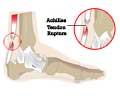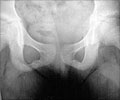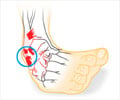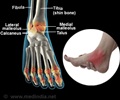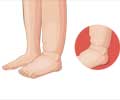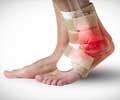- About Ankle pain - (http://www.mayoclinic.org/symptoms/ankle-pain/basics/definition/sym-20050796)
- More on Ankle pain - (http://www.mayoclinic.org/symptoms/ankle-pain/basics/causes/sym-20050796)
- Ankle Pain - (http://www.foothealthfacts.org/what-is/ns_ankle-pain.htm)
What is Ankle Pain - Symptom Evaluation?
Ankle pain can be a sign of injury or impairment in some part of the ankle joint. The ankle joint is a complex junction where the bones of the foot and the leg meet. It consists of three different joints: the talocrural joint or the ankle proper joint, the subtalar joint and the inferior tibiofibular joint. The ankle consists of both a hinge joint – for up and down motion - as well as a joint that allows for a slight rotation or side-to-side movement. The movements involved in this joint are dorsiflexion and plantarflexion of the foot.

The functions of the ankle and the foot include:
- Providing a base to hold the body weight.
- Rigid lever to propel the body forward during walking or running.
- Providing shock absorption for the force generated during walking, running, hopping and jumping.
The bones of an ankle joint include the tibia, the fibula and the talus (ankle bone). The important ligaments of the ankle joint are the anterior talofibular ligament, the posterior talofibular ligament and the calcaneofibular ligament. The Achilles tendon is the largest and strongest tendon involving the ankle and connects the back of the calf to the heel bone.
Pain in the ankle can result from injury to or inflammation in any of the bones, ligaments, tendons and muscles involved in the ankle joint. Possible locations of injury or inflammation that can cause ankle pain include the ankle, the heel, or any part of the foot or toe and the area along the edge of the toenail. The types of pain in an ankle joint can be:
- Pain and throbbing sensation
- Difficulty in pushing of with toes
- Inability to bear weight
- Swelling
- Redness or discoloration of the joint
- Stiffness
- Numbness and tingling
- Weakness
- Looseness of the joint

Ankle pain can be a symptom of various conditions such as sprain, nerve injury, osteoarthritis or even ill-fitting shoes.
Reasons for Ankle Pain
- Achilles tendinitis: This is an injury due to overuse of the Achilles tendon, and typically begins with a mild pain above the heel and back of the leg. The pain increases with prolonged walking, running, climbing or sprinting.
- Achilles tendon rupture: This is an injury that ruptures the back of the lower leg, and is often caused by strenuous physical or sports activity. The rupture occurs with a pop or a snap, and is accompanied with severe pain and swelling near the heel. An Achilles tendon rupture injury can make one unable to stand on one’s toes, unable to bend the foot downwards or to “push off” from the ground while walking.
- Ankle edema: This is an abnormal buildup of fluid, i.e. edema, in the ankles, feet or legs. Sometimes, a dull ankle pain is felt with ankle edema. The most common causes of ankle edema are pregnancy and being overweight. Infections, a surgery involving the leg, ankle or foot and increased age can also contribute to ankle edema. Sitting or standing for long periods of time, especially during travel, can also cause edema in the ankle and feet. Some medical conditions such as heart failure, kidney failure or liver failure may also cause a buildup of fluid in the body that can accumulate in the joints, especially in the ankles, causing ankle edema.

- Arthritis: Four types of arthritis, namely osteoarthritis, rheumatoid arthritis, septic arthritis and reactive arthritis can cause acute or chronic ankle pain, as well as stiffness and swelling of the affected joints.
- Bone spur: Bony projections that develop along the edges of bones of the feet could cause pain in the sole of the feet that can then radiate to the heel and the ankle.
- Bursitis: Fluid-filled sacs called bursa cushion the bones, tendons and muscles that meet at a joint. Inflammation of the bursa, known as bursitis, rarely affects the ankle joint. Pain, stiffness and swelling are the classic symptoms, which worsen on movement.
- Fracture of the ankle: Avulsion fracture is a type of fracture in which a fragment of bone tears away from the main mass of bone due to physical trauma. Stress fracture refers to tiny cracks in the bone caused mainly by overuse. Since the ankle is a joint that bears the entire weight of the body, there is a high risk of these types of fractures occurring, leading to pain and swelling in the foot and the ankle. A fracture in the bones of the ankle or the foot can be caused by something as simple as a single misstep or from a more serious accident, and can range from tiny cracks to broken bones.
- Gout: Gout is a condition in which urate crystals accumulate in the joints, due to high levels of uric acids in the blood. This causes intense joint pain, lingering discomfort and inflammation and redness of the affected joint. If an ankle joint is involved, there is presence of calcium pyrophosphate dehydrate crystals in the affected joint, causing stiffness, swelling and pain.

- Ill-fitting Shoes: Shoes that do not fit properly can often cause foot and ankle pain; ankle injury may also occur. Both shoes that fit loosely and tight-fitting shoes can put a lot of strain on the ankle and lead to foot problems and pain in the ankle. Walking for long periods of time in high-heeled shoes can put a lot of pressure on the toes and heels, and cause the ankles to bend at an awkward and unnatural angle, resulting in chronic ankle pain.
- Sprain and strain: A sprain is a stretching or tearing of ligaments and an ankle is often a common location for a sprain. Strain refers to a stretching or tearing of muscles or tendons and most commonly occurs in the lower back or in the muscles at the back of the thigh.
- Tarsal tunnel syndrome: The tarsal tunnel lies inside the median bump of the ankle, through which the tibial nerve travels and splits into three parts. Compression of this nerve can give rise to pain in the ankle or in any part of the foot it supplies. Symptoms include numbness, shooting pain, tingling, burning or sometimes a feeling similar to an electric shock. These sensations are typically felt on the inside of the ankle or at the bottom of the foot, but can also be felt in the heel, arch, toes or even the calf muscle. The pain or discomfort is aggravated with prolonged standing, walking or exercising.
Ankle Pain Clinical Evaluation
- Physical examination: Physical assessment includes that of gait pattern, standing posture and shoe wear pattern. The physician also looks out for any gross deformity, misalignment, atrophy, injuries, swelling and the development of ecchymosis (black and blue area due to blood vessel injury and escape of blood into the tissues).

- Palpation: All the parts of the lower leg, ankle and feet are felt with fingers to look out for any structural injuries.
- Assessment of range of motion: Active, passive and resistive ranges of motion are examined.
- Talar Tilt Test: This is a ligamentous stress test to determine the integrity of the lateral ankle ligaments.
- Anterior Drawer: The anterior talofibular ligament is a frequently injured ligament during an inversion ankle sprain and this test is done to determine the extent of injury to the ligament.
- External Rotation/Kleiger’s Test: When the rough edges of two bones are held together by a thick connective tissue, the joint is called syndesmosis. At the ankle, the tibia and fibula bones of the lower leg form a syndesmosis joint. Kleiger’s test is used to identify syndesmotic injuries at the ankle joint.
- Thompson’s Test: This test is used to identify a rupture in the heel cord.
- Compression Test: This test is used to assess the distal tibiofibular joint and fractures of tibia and fibula.
- Radiographic tests: X-rays, ultrasound, MRI, CT scan or bone scan are often used to confirm the diagnosis of ankle pain.


